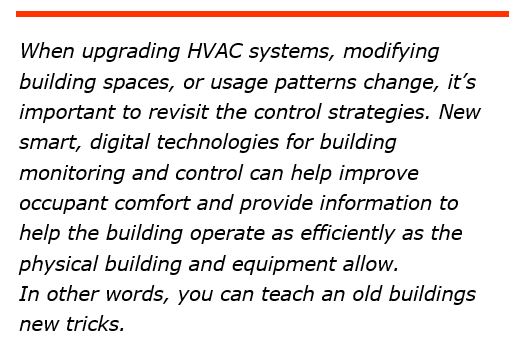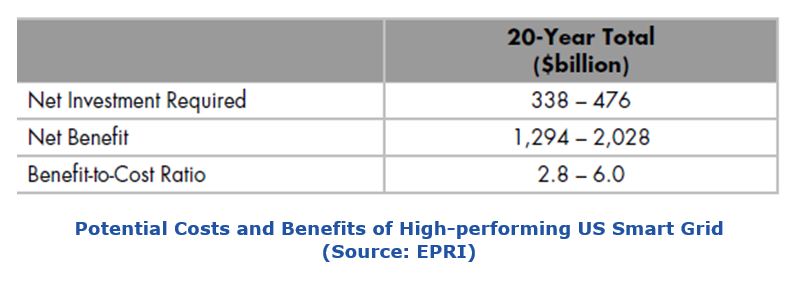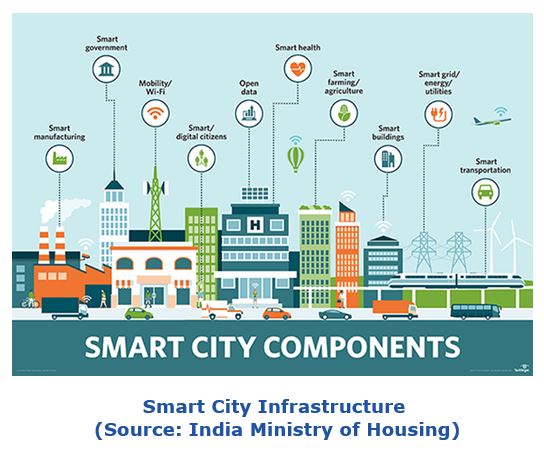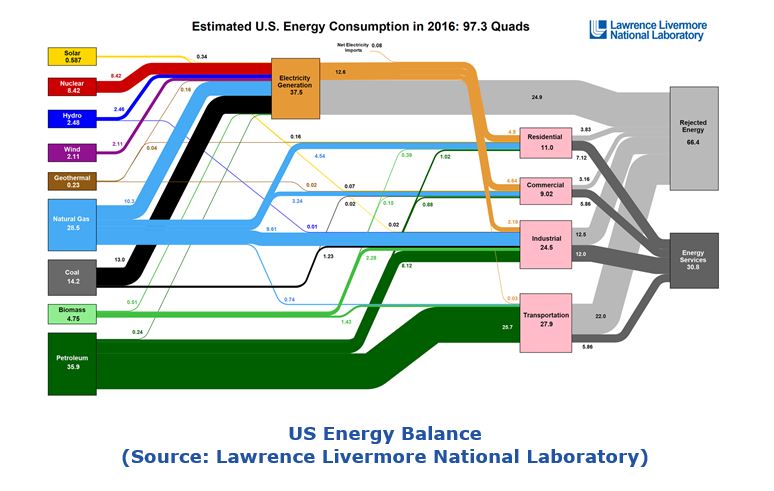

We have many opportunities to capture energy savings in our industrial, commercial, and residential buildings. Some are as basic as installing programmable thermostats or automated lighting systems to improve the way we operate the HVAC and lighting systems. Other options include actual modifications to the building itself or installing new or upgraded equipment. For example, we could install new windows; add 
While the building design will have the greatest impact on building energy consumption, the HVAC systems and lighting are the largest energy consumers in office and residential buildings. Buildings, and, to a lesser extent, HVAC systems, last a long time. When upgrading HVAC systems, modifying building spaces, or usage patterns change, it’s important to revisit the control strategies. New smart, digital technologies for building monitoring and control can help improve occupant comfort and provide information to help the building operate as efficiently as the physical building and equipment allow.
In this context, “smart” implies a proliferation of embedded systems, gateway communications, data collection, control systems, and data management; plus, significant stakeholder interaction with building equipment and the building energy networks. With improved monitoring and control, you can teach an old building new tricks.
Below are some of the many energy-saving opportunities available for smart buildings within the larger context of emerging smart cities and smart grids. New automation paradigms are at the heart of the smart city concept.
Electric grids provide power to a town or city. The cost of that power includes generation costs, transmission, and distribution costs. One way a smart city can reduce these costs is to better manage peak loads through demand response strategies.
Basically, a town or city must pay for the size of the grid wires that feed electricity to the city utility from a transmission system. The size of that wire and the generation resources needed are typically determined by the peak transmission load for a one-hour period when electricity demand is highest. The peak hour may be from 5:00 pm to 6:00 pm on a hot summer day, and charges would apply for the whole year. The city utility will pay transmission charges related to the size of the wire and capacity charges related to the amount of generating capacity that is needed to service the peak load. By reducing the amount of power consumed during these peak times, the city would save on its peak transmission load costs. The power generation side would also be able to avoid having to build peaking power plants, which may only run 5 percent of the time, but must be ready to run for the next heat wave. Smart buildings could help better manage these peak loads, and thus help reduce a municipality’s overall electricity costs, by as much as 20 percent.
Smart city-enabled demand response strategies offer the potential to reduce power costs and improve grid reliability. It’s difficult to coordinate energy-consuming machinery in the buildings throughout a town. To do so effectively, requires a high level of interaction between the utility and the consumer. To achieve a significant reduction in peak load through demand response, the utility could operate high-consumption resources inside many buildings remotely, or the building owner could respond to price signals. This would require a financial agreement between the utility and the customers about when each resource could be deployed and how to structure dynamic pricing signals.
Smart meters with AMI (advanced metering infrastructure) can help implement control strategies using pricing signals. Measurement information from smart meters should be made available to customers with a web interface, which would improve customer involvement and understanding of usage patterns. But smart meters are only part of the demand response solution. Appropriate control strategies are also needed to remotely manipulate devices using load centers and communications links to building equipment, like EV chargers, water heating, HVAC systems, or lighting systems.
For example, with code-approved Wi-Fi circuit breakers in a building’s load panel, IoT gateways could enable the utility or building owner to adjust the building’s loads, such as HVAC control systems, as needed to manage peak loads. Grid operators faced with upcoming load control issues routinely use telephone calls to large industrial users to prepare for load shedding. Automatic utility load shedding for most industrial processes has so far been too complex to automate. Electric customers need to be involved with certain load shedding activities, because they may have situations where load shedding could be costly. It could be the industry has a critical project shipment scheduled and curtailing power would impact that. It could be a resident needs the EV, the HVAC, or hot water for unusual circumstances. Industrial power customers respond to “LMP” (Local Marginal Price) of power currently updated every hour here in New England. Residential customers have at most a discounted night rate for power.
What is emerging is a more transactional electric grid where all customers, regardless of size, will see prices for power change through the day and at different locations. The LMP price includes costs for energy, congestion, and losses and during peak loads, it can increase sharply rewarding curtailment and penalizing peak load consumption. With real-time variations and markets for looking ahead, energy consumers will increasingly be involved with grid operation via demand response. The emerging transactional electric grid will rely on smart metering and smart load centers. Smart phone applications developed by utilities and aggregators are evolving to allow the smaller power customers to participate in the wholesale power and ancillary services markets that were previously restricted to large generators and industrial customers.
Not every control strategy needs to be closed loop. A utility or aggregator could text participating residential consumers for voluntary actions, such as adjusting thermostats or shutting off other large loads. With advanced notice of a peak load event a customer could pre-cool/heat a living space to coast through a peak load event. It will be a change for residential and small commercial customers to respond to grid pricing signals.
As residential homes and other buildings shift to more distributed energy resources (DER), photovoltaic (PV) systems with batteries will increasingly be part of the building infrastructure. Suddenly, buildings have a two-way flow of power, providing additional opportunities to participate in a demand response control strategy. Microgrids with batteries could push power into the grid during the peak load times, enabling peak shaving services. And, as the price of battery storage drops over time, it’s realistic to expect to see these microgrids and nanogrids proliferate. Utilities are developing new smart grid-enabled business models to provide stakeholders with the needed financial motivation.
The table below, based on an EPRI study, shows the potentials costs and benefits for a high-performing US smart grid:

Based on the projected net benefit, utilities and private equity firms alike are recognizing the opportunities and making unprecedented investments. Utility deregulation and the shift from state-owned, centralized power generation to distributed energy providers is changing the structure of our power grids.
While smart grids impact the OpEx part of the energy equation, the CapEx opportunities are also important. Energy conservation starts when buildings are designed and constructed. When buildings no longer meet their new purpose, they must be either repurposed or torn down and rebuilt to serve a need. The latter approach in particular creates waste, since it requires new building materials and the associated energy needed to create them.
The embedded energy needed to create building materials is a part of the energy-saving equation. Concrete, for example, contains a high level of embedded energy. Worldwide programs like LEED (Leadership in Energy and Environmental Design) rate buildings and help support the reputation of companies that build, own, and use them. LEED provides a framework to create healthy, highly efficient and cost-saving “green” buildings. LEED certification is a globally recognized symbol of sustainability achievement. Also, while the International Building Code (IBC) and other codes have greatly improved new building energy efficiency, many cities have signed up for so called “stretch codes” that take building efficiency to a higher level. 
New smart HVAC and lighting systems enable building operators to choose from a host of IoT sensors, BAS (building automation system) tools, edge gateways, and communications networks to create better buildings in which people can live and work. Smart buildings can embrace the occupants, sense their presence, guide them to resources they desire, connect them to their town or city, and adapt to usage patterns.
The choices made for the HVAC and lighting systems have a big impact on a building’s energy consumption. New heat pump technology has greatly improved efficiency for use in heating buildings in cold climates. Some HVAC systems include thermal storage to shift load. New LED lighting has also greatly reduced the energy needed for lighting.
Some of the very first utility power plants were built in city centers and used the waste heat energy from electric generation to heat buildings. This co-generation, or combined heat and power (CHP) strategy is very energy efficient and many college campuses, hospital complexes, and industrial sites with captive power plants use this approach. Unfortunately, in most cases today, central fossil and nuclear power plants are located remotely from town and city buildings. Local power generation and load management will present opportunities for storing thermal energy for load shifting, as well as recovering waste heat from backup generators and other equipment..
The energy balance depicted in the following diagram shows how the US consumes energy and suggests how energy consumption can be reduced.

Clearly, due to the large amount of energy they consume, residential, commercial, and industrial buildings of all kinds offer an opportunity to improve energy efficiency.
Many of today’s buildings and building complexes utilize local generation with solar, wind, and diesel, with increasing use of batteries to form microgrids and integration with their energy sources.
Grid reliability remains a top priority for all electric distribution systems and building operators depend on a stable reliable grid. Grid resiliency has emerged as a highly desirable function, especially in those developing countries that do not have a stable macro grid. Puerto Rico, for example lost its main electric grid in a hurricane, and even months later it was still not fully operational.
Critical infrastructure like hospitals, fire, police, and cell towers are being rebuilt with microgrids that often have solar PV, diesel generators, and battery storage that can operate with or without the macro grid. This distributed generation adds resiliency and is an emerging new grid architecture. Most residential and commercial PV systems are grid-tied and require the grid to operate. However, new tariff structures and lower-cost batteries are resulting in new residential PV systems with batteries that can operate in island or grid-tied mode. Increasingly, buildings are becoming microgrids and the way these microgrids and the building loads interact with the utility grid present many opportunities to reduce electric power costs.
The electric grid is evolving fast and utilities are developing new business models to adapt. While this is not easy to do, it clearly offers opportunities for utilities and their industrial, commercial, and residential customers to benefit. Based on industry studies, we know that the benefits of a smart grid can greatly exceed the implementation costs. Building energy management is very much integrated into the smart grid and - together - they are part of the smart city.
Based on ARC research and analysis, we recommend the following actions for utilities, technology suppliers, and building owner-operators:
ARC is prepared to assist you and your organization. Just click on the “Contact Us” icon below.
Keywords: Building Energy, Smart Cities, Smart Meters, Microgrid, Smart Grid, Distributed Energy Generation, Demand Response, Solar, Wind, HVAC, Lighting, ARC Advisory Group.

